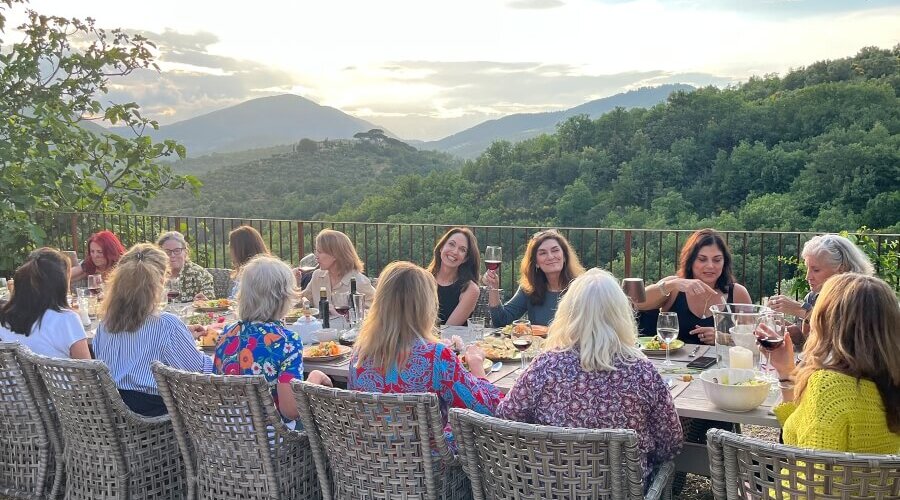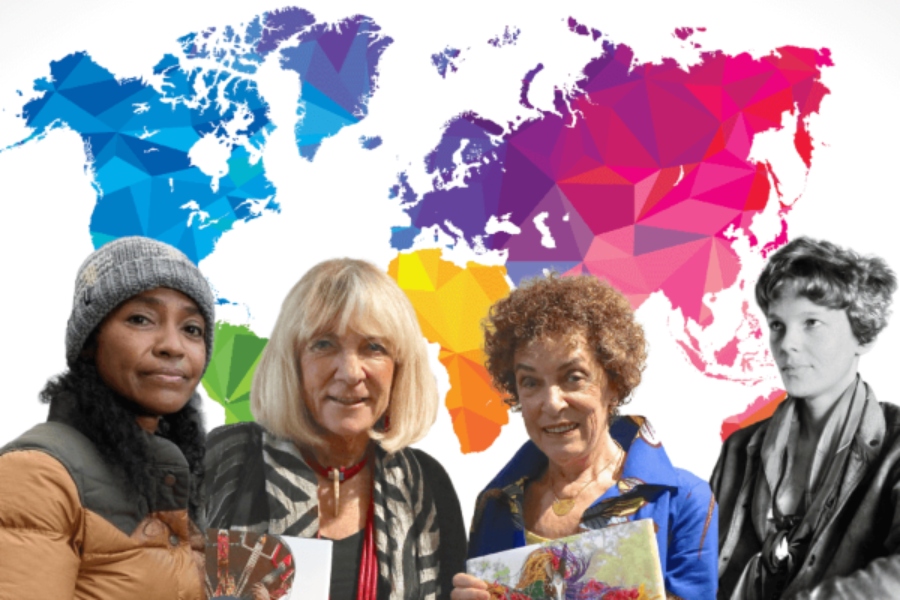One day—a bad day at the office—I took myself on a little walk for some retail therapy and found myself in Barneys (Ack! Out of my price range!), mesmerized by a case of jewelry that had my eyes spinning like pinwheels. Chunky Kelly-green emeralds, kaleidoscopic opals, luminescent moonstones, and Jolly Rancher-esque rubies were set in simple but playful ways, surrounded by mellow yellow gold. I wanted to gobble them up, but since that wasn’t an option, my next desire was to learn more about whose hands had created them.
And that curiosity led me to their designer, Judy Geib. Raised in Reading, Pennsylvania, she is one of those “born to create” types who always loved making things—all kinds of things. Settling in New York after college, she worked in architecture and book design and continued creating in her free time, whether that meant painting or other arts.
But then she tried her hand at jewelry—and something clicked. This was it. She’d found something she truly loved and set out to pursue it with knowledge gleaned from a basic how-to book and a plumber’s torch in hand. Her designs married simple, hand-crafted charm and luxe gemstones, chosen with her fabulous eye for color. Her first collection of 12 items debuted in 2002; she took it to Barneys New York, which has been carrying her work ever since.
Her signature look has a delightfully handcrafted feel—warm gold that has a primitive allure and big, bright chunky gemstones. There are no glittery gobs of sparkling diamonds or delicate filigree work—this is jewelry that reflects the human being who made it, with an almost Medieval vibe.
This signature look may stem from the fact that she does, in essence, design with her hands. She doesn’t engineer pieces by making molds and models and calibrating stone weights. Rather, she lets the gems and metals inspire here and dives in and begins crafting. “With jewelry, you can play and experiment, try and fail,” Judy says. “I find it comforting to know that the materials are never entirely lost: they can always be reclaimed.”
A member of the elite Council for Fashion Designers of America, Judy shared with NextTribe more of her story of how she began her business and built her amazing brand.

A set of Judy Geib pins.
When did you become interested in jewelry?
Like many little kids I loved playing in my mother’s jewelry box, though it was high on glitter and costume and pretty much devoid of gorgeousness. My grandmother, though, wore a lovely diamond brooch on her threadbare housedress every day without exception. In my 20s, I had a friend who collected antique jewelry, and that piqued my interest. I grew to love old jewelry, which is the inspiration for so much of my work.
Read More: Elise Pettus, Divorce Whisperer, Is Guiding Women Through the Big Split
Tell us a bit about your career in graphic design … and how did you find yourself gravitating to jewelry design?
I studied fine arts at Kutztown State College and then moved to New York and started working for the architect Peter Eisenman. There I was introduced to graphic design (Peter loved to publish as much as he loved to design buildings), but I knew design was not my passion, and I did not really know what was. I had loved making things, though, since I was small—it was always my hobby and pleasure. And then one day, when I could not indulge in my desire for the lovely antique jewelry I would see and want, I set out to make it for myself. I realized that that was the only way to get it. I continued designing books for a few years during the transition to calling myself a jeweler, but the idea worked, and I have a pretty enormous collection of amazing jewelry now!!
I want to emphasize, though, that I did not gravitate toward “jewelry design.” I started making jewelry. I never designed it. I still do not “design.” I have an idea, and I set about to make it. It always changes quite a bit along the way.

Pair of emerald pave rings designed by Judy Geib.
We understand you are largely self-taught, from a book—can you tell us about that?
What I loved about antique jewelry was seeing the hand that made it—I knew that’s what I wanted to make. I found an extremely utilitarian book, Jewelry Making for Schools, Tradesmen Craftsmen. It was just what I needed—the straight information, with limited aesthetics. I taught myself with that.
What inspires your designs?
The easiest inspiration is the stones. When you use stones, pieces can sometimes make themselves. The hardest thing is just metal … it is more like a blank canvas. What is the starting point? Where to begin? Sometimes there is a hint of an idea, like Rorschach [inkblots], or concentric circles. The Reuters logo on a building I passed on a train gave me an idea for how to use a parcel of different-sized rubies—it was a logo of dots in ascending and descending sizes, and I thought I could use that calligraphically. Then there are things one loves. In my case, calligraphy, textiles, crafts. All of these things can get an idea started, and once you start, things usually take on lives of their own.

Judy Geib ‘Fern’ necklace.
How did you transition to having it be your full-time job? Can you tell us about a moment when you thought, “OK, I think I’m on my way!”
I am not sure there was an a-ha moment like that. I bet most people who have their own businesses will tell you that there is worry for years. It has taken me 20 years to think that maybe I do not have to worry all the time; maybe I do not have to work 24/7 anymore. But there is still a lot of work and worry and being constantly blindsided in trying to run your own business. The pluses are that you do what you are passionate about and you are your own boss. The minuses are that you are the person paying for your own vacation while doing all of the day to day. That is my case—I am frugal in my business, entirely self-owned, and I do all of the administrative work, and not that well. But I have a very small team that works along side of me making, and they are amazingly fabulous.
Read More: From Office Worker to Ice Road Trucker to Arts Colony Founder—How She Did It
Was there a bit of advice that guided you? Or someone who helped you navigate starting your own business?
It was my friend Miki Higasa, who now does my brand strategy and PR. She had faith in my work. I had no idea what she did, as we met as friends without really knowing what the other did professionally. But when she started her own firm, I told her I wanted to be her client, not knowing what that meant! Believe me, I was (and still am to a certain extent) naïve about the fashion world, but her support has been completely instrumental to my success. She never gave me a word of advice about what I should make. She always told me to do what I think I should do. That is invaluable. I believe the best advice is to help people do what they want to do, and she helped me find that.

‘Kaleidoscope’ pin designed by Judy Geib.
We heard you travel a lot to find the incredible stones you work with—can you share a story about your biggest adventure doing so?
My most fun memory was going to Teófilo Otoni, Minas Gerais [a Brazilian city known for its mining of precious stones], for a week a few years ago. I had lived in Brazil for my last two years of high school with my family, so I do know some Portuguese, and I can get around. I landed in Rio and went straight to the central bus station, a crowded spot in a gritty part of town. I remember having lunch outside in an open-air market, fried fish (delicious, about $.25)—I got the feeling I was the only foreigner ever to have done that (unless Anthony Bourdain was there before me)—and it was lovely.
I got on the bus for the 17-hour trip, swerving through the amazing rock formations leading to the countryside. The bus drivers are excellent, although they cross themselves and pray at every bus stop. Then I met a colleague, who knows everyone and agreed to help me with stones. We headed to the central plaza and stood there. Little by little, men appeared bearing paper-wrapped parcels of stones, opening them to show us.
Later in the day, we went to a small office to look at things carefully. A crowd formed outside, and we sat at a table with good light, seeing vendors one by one. This lasted for a day, punctuated by swimming in a huge pool, drinking tropical fruit juices, and dining outside on the regional specialty, air-dried meat. I just enjoyed it so much. In the end, I traveled back with a bag full of amazing stones to start work.
What advice would you give a woman looking to shift careers, especially to one involving design?
I don’t know if I did this the right way, but it worked for me. I think that means that each person has to find the way that works best for them. I had no expectations when I started, no plans, no cash projections. I was just moving along, making things, and trying to take advantage of opportunities when they arose. I was surprised when my pieces started selling, but at the same time I had no pressure because I still had a fulltime job doing graphic design, and I did not have to worry about making money from the jewelry. I think I never would have succeeded if I had felt as if I was under pressure—I like to do things that I am not expected to do, and I really don’t like to do things I am supposed to do. My best work comes when I am not expecting it.
All images captured by Dirk Vandenberk
***
Janet Siroto has held the Editor-in-Chief position at Time Inc.’s Family Life magazine, as well as senior editorial positions at Cosmopolitan, Redbook and Good Housekeeping. Her writing work has appeared in New York, The New York Times, Vogue and many others.





















0 Comments